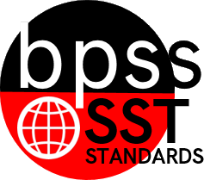SST-07.6
 Standard 6: Standard 6:
Human Development and Behavior
Students understand the importance of culture, individual identity, and group identity.
|
Narrative for the Human Development and Behavior
In the future this will contain narratives and other information about the Standard.
Calculation Method for Standards
Standards are larger groups of related benchmarks. The Standard Grade is a calculation of all the related benchmarks. Click on the benchmark name below each Standard to access the learning targets and proficiency rubrics for each standard's related benchmarks. |
|
SST-07.6.01
|
7th Grade SST Targeted Benchmarks
Standard 6: Human Development
SST-07.6.01 Identify principles governing individual and group behavior (e.g., cooperation, collaboration, power, conflict) within social dynamics (e.g., familial, political, religious).
|
Student Learning Targets:
Knowledge Targets
Reasoning Targets
Skills (Performance) Targets
Product Targets
Proficiency Scale
| Score |
|
Description |
Sample Activity
|
| 4.0 |
In addition to Score 3.0, the student demonstrates in-depth inferences and applications regarding more complex material that go beyond end of instruction expectations. |
- |
| |
3.5 |
In addition to Score 3.0 performance, the student demonstrates in-depth inferences and applications regarding the more complex content with partial success. |
| 3.0 |
“The Standard.” The student demonstrates no major errors or omissions regarding any of the information and processes that were end of instruction expectations. |
- |
| |
2.5 |
The student demonstrates no major errors or omissions regarding the simpler details and processes (Score 2.0 content) and partial knowledge of the more complex ideas and processes (Score 3.0 content). |
| 2.0 |
The student demonstrates no major errors or omissions regarding the simpler details and processes but exhibits major errors or omissions regarding the more complex ideas and processes (Score 3.0 content). |
- |
| |
1.5 |
The student demonstrates partial knowledge of the simpler details and processes (Score 2.0 content) but exhibits major errors or omissions regarding the more complex ideas and procedures (Score 3.0 content). |
| 1.0 |
With help, the student demonstrates a partial understanding of some of the simpler details and processes (Score 2.0 content) and some of the more complex ideas and processes (Score 3.0 content). |
- |
| |
0.5 |
With help, the student demonstrates a partial understanding of some of the simpler details and processes (Score 2.0 content) but not the more complex ideas and processes (Score 3.0 content). |
| 0.0 |
Even with help, the student demonstrates no understanding or skill. |
- |
Resources
Websites
Vocabulary |
|
SST-07.6.02
|
7th Grade SST Targeted Benchmarks
Standard 6: Human Development
SST-07.6.02 Explain how individuals and institutions influence one another (e.g., social processes, peaceful and violent demonstrations, picketing, protests, petitions, group affiliation, citizenship, voting).
|
Student Learning Targets:
Knowledge Targets
Reasoning Targets
Skills (Performance) Targets
Product Targets
Proficiency Scale
| Score |
|
Description |
Sample Activity
|
| 4.0 |
In addition to Score 3.0, the student demonstrates in-depth inferences and applications regarding more complex material that go beyond end of instruction expectations. |
- |
| |
3.5 |
In addition to Score 3.0 performance, the student demonstrates in-depth inferences and applications regarding the more complex content with partial success. |
| 3.0 |
“The Standard.” The student demonstrates no major errors or omissions regarding any of the information and processes that were end of instruction expectations. |
- |
| |
2.5 |
The student demonstrates no major errors or omissions regarding the simpler details and processes (Score 2.0 content) and partial knowledge of the more complex ideas and processes (Score 3.0 content). |
| 2.0 |
The student demonstrates no major errors or omissions regarding the simpler details and processes but exhibits major errors or omissions regarding the more complex ideas and processes (Score 3.0 content). |
- |
| |
1.5 |
The student demonstrates partial knowledge of the simpler details and processes (Score 2.0 content) but exhibits major errors or omissions regarding the more complex ideas and procedures (Score 3.0 content). |
| 1.0 |
With help, the student demonstrates a partial understanding of some of the simpler details and processes (Score 2.0 content) and some of the more complex ideas and processes (Score 3.0 content). |
- |
| |
0.5 |
With help, the student demonstrates a partial understanding of some of the simpler details and processes (Score 2.0 content) but not the more complex ideas and processes (Score 3.0 content). |
| 0.0 |
Even with help, the student demonstrates no understanding or skill. |
- |
Resources
Websites
Vocabulary |
|
SST-07.6.03
|
7th Grade SST Targeted Benchmarks
Standard 6: Human Development
SST-07.6.03 Compare how cultures throughout the world meet human needs and concerns (e.g., religion, sense of belonging, celebrations).
|
Student Learning Targets:
Knowledge Targets
- I can match holidays and traditions with certain regions.
Reasoning Targets
- I can compare cultures within the Western Hemisphere.
- I can explain (verbally) the significance and reasons for items included on poster, including the connection to culture in the United States.
Product
- I can create a representation (poster, technological representation, etc.) of culture as a way of life.
Proficiency Scale
| Score |
|
Description: SST-07.6.3 Compare how cultures throughout the world meet human needs and concerns (e.g., religion, sense of belonging, celebrations). |
Sample Activity
|
| 4.0 |
The student:
- demonstrates extended knowledge of cultures, and explores cultural needs of society further than what is discussed in class.
|
-culture poster |
| |
3.5 |
In addition to Score 3.0 performance, the student demonstrates in-depth inferences and applications regarding the more complex content with partial success. |
| 3.0 |
The student can:
- create a representation (poster, technological representation, etc.) of culture as a way of life.
- explain (verbally) the significance and reasons for items included on poster, including the connection to culture in the United States.
The student exhibits no major errors or omissions.
|
- |
| |
2.5 |
The student demonstrates no major errors or omissions regarding the simpler details and processes (Score 2.0 content) and partial knowledge of the more complex ideas and processes (Score 3.0 content). |
| 2.0 |
There are no major errors or omissions regarding the simpler details and processes as the student:
- creates a representation (poster, technological representation, etc.) of culture.
- explains the items included on the poster, but isn’t able to include the connection to culture in the United States.
However, the student exhibits major errors or omissions regarding the more complex ideas and processes.
|
- |
| |
1.5 |
The student demonstrates partial knowledge of the simpler details and processes (Score 2.0 content) but exhibits major errors or omissions regarding the more complex ideas and procedures (Score 3.0 content). |
| 1.0 |
With help, the student demonstrates a partial understanding of some of the simpler details and processes (Score 2.0 content) and some of the more complex ideas and processes (Score 3.0 content). |
- |
| |
0.5 |
With help, the student demonstrates a partial understanding of some of the simpler details and processes (Score 2.0 content) but not the more complex ideas and processes (Score 3.0 content). |
Resources
Websites - Provided by individual teacher
Vocabulary - Provided by individual teacher
|
|
SST-07.6.04
|
7th Grade SST Targeted Benchmarks
Standard 6: Human Developmnent
SST-07.6.04 Explain how “push” (e.g., war, famine) and “pull” (e.g., economics, safety, family) factors rearrange and create new human landscapes (e.g., modify existing cultures).
|
Student Learning Targets:
Reasoning Targets
- I can analyze what pushes people away.
- I can analyze what pulls people in.
- I can explain why people move to a new area.
Proficiency Scale
| Score |
|
Description |
Sample Activity
|
| 4.0 |
In addition to Score 3.0, the student demonstrates in-depth inferences and applications regarding more complex material that go beyond end of instruction expectations. |
- |
| |
3.5 |
In addition to Score 3.0 performance, the student demonstrates in-depth inferences and applications regarding the more complex content with partial success. |
| 3.0 |
The student demonstrates no major errors or omissions regarding any of the information and processes that were end of instruction expectations.
The student:
|
- |
| |
2.5 |
The student demonstrates no major errors or omissions regarding the simpler details and processes (Score 2.0 content) and partial knowledge of the more complex ideas and processes (Score 3.0 content). |
| 2.0 |
The student demonstrates no major errors or omissions regarding the simpler details and processes but exhibits major errors or omissions regarding the more complex ideas and processes (Score 3.0 content) as the student:
- defines push-pull theory.
|
- |
| |
1.5 |
The student demonstrates partial knowledge of the simpler details and processes (Score 2.0 content) but exhibits major errors or omissions regarding the more complex ideas and procedures (Score 3.0 content). |
| 1.0 |
With help, the student demonstrates a partial understanding of some of the simpler details and processes (Score 2.0 content) and some of the more complex ideas and processes (Score 3.0 content). |
- |
| |
0.5 |
With help, the student demonstrates a partial understanding of some of the simpler details and processes (Score 2.0 content) but not the more complex ideas and processes (Score 3.0 content). |
Resources
Websites - Provided by individual teacher
Vocabulary - Provided by individual teacher |
|
SST-07.6.05
|
7th Grade SST Targeted Benchmarks
Standard 6: Human Development
SST-07.6.05 Explain how rivalry and tension between cultures contribute to world conflict.
|
Student Learning Targets:
Knowledge Targets
Reasoning Targets
Skills (Performance) Targets
Product Targets
Proficiency Scale
| Score |
|
Description |
Sample Activity
|
| 4.0 |
In addition to Score 3.0, the student demonstrates in-depth inferences and applications regarding more complex material that go beyond end of instruction expectations. |
- |
| |
3.5 |
In addition to Score 3.0 performance, the student demonstrates in-depth inferences and applications regarding the more complex content with partial success. |
| 3.0 |
“The Standard.” The student demonstrates no major errors or omissions regarding any of the information and processes that were end of instruction expectations. |
- |
| |
2.5 |
The student demonstrates no major errors or omissions regarding the simpler details and processes (Score 2.0 content) and partial knowledge of the more complex ideas and processes (Score 3.0 content). |
| 2.0 |
The student demonstrates no major errors or omissions regarding the simpler details and processes but exhibits major errors or omissions regarding the more complex ideas and processes (Score 3.0 content). |
- |
| |
1.5 |
The student demonstrates partial knowledge of the simpler details and processes (Score 2.0 content) but exhibits major errors or omissions regarding the more complex ideas and procedures (Score 3.0 content). |
| 1.0 |
With help, the student demonstrates a partial understanding of some of the simpler details and processes (Score 2.0 content) and some of the more complex ideas and processes (Score 3.0 content). |
- |
| |
0.5 |
With help, the student demonstrates a partial understanding of some of the simpler details and processes (Score 2.0 content) but not the more complex ideas and processes (Score 3.0 content). |
| 0.0 |
Even with help, the student demonstrates no understanding or skill. |
- |
Resources
Websites
Vocabulary |
|
 BPS District Social Studies Standards Book
BPS District Social Studies Standards Book

 Standard 6:
Standard 6: